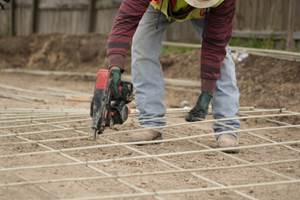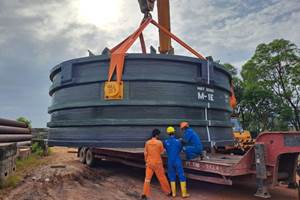Growth markets for composite materials in civilinfrastructure
In the last decade, the composites industry has set ambitious goals in the vast civil infrastructure market.
Share
Read Next
In the last decade, the composites industry has set ambitious goals in the vast civil infrastructure market. Fiber-reinforced polymer (FRP) composite materials have been offered as solutions for longer-lasting bridges and piers, corrosion-resistant pilings, low-maintenance bridge decks, lightweight and durable utility poles, and long-lasting sheet piling retaining structures. Thanks in part to the leadership role of the Market Development Alliance (MDA) of the U.S. FRP composites industry, much progress has been made. Dozens of FRP demonstration bridges have been built in the U.S. alone, proving to civil engineers that FRP composites can hold up to the combination of severe fatigue loading, freeze-thaw cycles, and exposure to de-icing chemicals. Building and bridge code standards for many FRP composite products have been developed, and more are on their way. The American Concrete Institute has developed design methodologies for FRP reinforcing bars, while the Federal Highway Administration is completing design codes for FRP composite bridges. Yet it remains difficult to break into these markets. Concrete, steel, and timber construction are very well established and, in most cases, difficult for all-FRP structures to beat on a first-cost basis. While there are always niche markets where reduced weight will allow FRP to compete on a first-cost basis, such as draw bridges, or lightweight FRP deck replacements for historic steel trusses, FRP otherwise have difficulty competing on a first-cost basis with steel construction (at less than $1/lb) or concrete (at less than 2 cents/lb). Moreover, it's not easy to get civil engineers to design with these new materials and risk their "Professional Engineer" stamp for the promise of lower life-cycle costs. Nor is it a simple task to sell lower life-cycle cost composite bridges to today's cash-strapped municipalities and departments of transportation. Procurement realities for most public and private agencies do not accommodate the greater initial cost of FRP, even with a promise of lower life-cycle costs. With limited budgets and billions of dollars in construction backlogged, departments of transportation will continue to be under pressure to accept the lowest bid, rather than the lowest life-cycle bid.
So if you can't beat them? Join them. In the near-term, the largest potential role for FRP construction may be to complement and enhance — rather than replace — traditional construction materials. Here, the $800 billion per year U.S. construction industry may still offer numerous growth opportunities. FRPs provide an economically proven alternative to repair, upgrade and strengthen traditional construction materials. For example, successful applications include FRP wraps for seismic upgrade of concrete columns, FRP strengthening of existing reinforced and prestressed concrete beams and slabs, FRP field strengthening of steel components, FRP retrofit of masonry walls, and FRP strengthening of timber construction.
On the timber front, the University of Maine Advanced Engineered Wood Composites Center has demonstrated significant benefits of marrying FRPs with wood-based composites in a variety of end-use applications, including beams, structural panels, trusses, connections, and disaster-resistant housing. For example, FRP-glulams are obtained by reinforcing the tension and/or compression sides of glued laminated (glulam) timber beams with fiber-reinforced polymers. In an ongoing project to develop American Association of State Highway Transportation Officials (AASHTO) bridge design specifications, the University of Maine Center tested 150 FRP-glulam beams. Test results showed that as little as 2 percent FRP tension reinforcement increased girder bending strength by over 100 percent. Reinforcement also reduced inherent variability in the mechanical properties of wood, which allows for higher design values. The size-effect (called the volume effect in the glulam timber industry, referring to the tendency for there to be larger strength-reducing defects in larger beams) for FRP-glulam beams gradually disappears with increasing tension reinforcement ratios, and the volume effect is eliminated at an E-glass tension reinforcement ratio of 2 percent. This result is particularly significant for long glulam girders where the volume effect may reduce bending strength by up to 30 percent. Tension reinforcement also increases ductility, which provides for a safer failure mechanism. Ductility ratios near three have been calculated from beam laboratory test results. With the increased strength, reduced variability, and elimination of the size effects, high-performance FRP-wood composites such as FRP-glulam girders may present new commercial opportunities for both the FRP and the timber industry.
New technologies that take advantage of combining FRP with traditional construction materials (timber, steel, concrete, and masonry) may thus provide for continued growth of composites in the civil infrastructure market. To reap these benefits, technology development needs to proceed hand-in-hand with performance-based building code development and continued education of civil engineers in FRP design.
Related Content
Composites reinvent infrastructure
Celebrating National Composites Week, CW shares ways in which composites continue to evolve the way we approach infrastructure projects.
Read MoreRecycling end-of-life composite parts: New methods, markets
From infrastructure solutions to consumer products, Polish recycler Anmet and Netherlands-based researchers are developing new methods for repurposing wind turbine blades and other composite parts.
Read MoreGatorbar, NEG, ExxonMobil join forces for composite rebar
ExxonMobil’s Materia Proxima polyolefin thermoset resin systems and glass fiber from NEG-US is used to produce GatorBar, an industry-leading, glass fiber-reinforced composite rebar (GFRP).
Read MoreComposites end markets: Infrastructure and construction (2024)
Composites are increasingly used in applications like building facades, bridges, utility poles, wastewater treatment pipes, repair solutions and more.
Read MoreRead Next
All-recycled, needle-punched nonwoven CFRP slashes carbon footprint of Formula 2 seat
Dallara and Tenowo collaborate to produce a race-ready Formula 2 seat using recycled carbon fiber, reducing CO2 emissions by 97.5% compared to virgin materials.
Read MorePlant tour: Daher Shap’in TechCenter and composites production plant, Saint-Aignan-de-Grandlieu, France
Co-located R&D and production advance OOA thermosets, thermoplastics, welding, recycling and digital technologies for faster processing and certification of lighter, more sustainable composites.
Read More“Structured air” TPS safeguards composite structures
Powered by an 85% air/15% pure polyimide aerogel, Blueshift’s novel material system protects structures during transient thermal events from -200°C to beyond 2400°C for rockets, battery boxes and more.
Read More


















